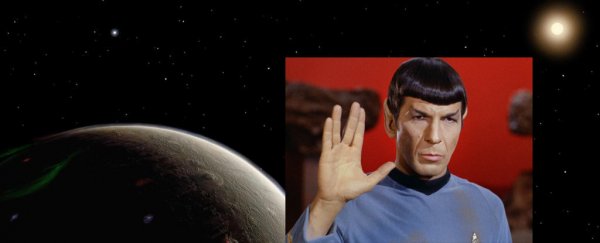So far, astronomers have identified thousands of exoplanets out there beyond the reaches of the Solar System, but only a rare few are the stuff of legend. Such is the case with an Earth-like exoplanet, found orbiting a star called 40 Eridani A - Star Trek creator Gene Roddenberry's preferred location for Vulcan, the home planet of Mr Spock.
Located around 16 light-years from Earth in the southern constellation of Eridanus, 40 Eridani A is part of a triple-star system. Although it was never mentioned in the original TV series of Star Trek, it had been put forward as a proposed location for the planet by related literature.
In 1991, Roddenberry and three astronomers from the Harvard-Smithsonian Center for Astrophysics wrote a letter to Sky & Telescope magazine laying out their choice for Vulcan's location, and why.
"Star Trek 2 by James Blish and Star Trek Maps by Jeff Maynard and others name the star 40 Eridani as Vulcan's sun. The Star Trek Spaceflight Chronology by Stan and Fred Goldstein cites Epsilon Eridani instead," they wrote in their letter.
"We prefer the identification of 40 Eridani as Vulcan's sun because of what we have learned about both stars at Mount Wilson … The HK observations suggest that 40 Eridani is 4 billion years old, about the same age as the Sun. In contrast, Epsilon Eridani is barely 1 billion years old.
"Based on the history of life on Earth, life on any planet around Epsilon Eridani would not have had time to evolve beyond the level of bacteria. On the other hand, an intelligent civilisation could have evolved over the aeons on a planet circling 40 Eridani. So the latter is the more likely Vulcan sun."
Epsilon Eridani does have one planet - an uninhabitable gas giant. Now astronomers on the University of Florida-led Dharma Planet Survey have found something that seems a bit more habitable orbiting 40 Eridani A.
More precisely, it's an object known as a super-Earth - a rocky planet around twice the size of Earth, orbiting 40 Eridani A just inside the system's habitable zone - not too hot and not too cold. It completes one orbit every 42 (Earth) days.
So life on the planet isn't unfeasible.
"The orange-tinted HD 26965 [40 Eridani A] is only slightly cooler and slightly less massive than our Sun, is approximately the same age as our Sun, and has a 10.1-year magnetic cycle nearly identical to the Sun's 11.6-year sunspot cycle," said astronomer Matthew Muterspaugh of Tennessee State University.
"Therefore HD 26965 may be an ideal host star for an advanced civilisation."
The aim of the Dharma Planet Survey, using the 50-inch Dharma Endowment Foundation Telescope (DEFT) on Mount Lemmon in Arizona, is a dedicated survey to find low-mass planets orbiting bright, nearby stars.
It uses the radial velocity method - detecting the very slight wobble in a star's position due to the gravitational pull of an exoplanet. The candidate exoplanet, named HD 26965b (but we'll probably call it Vulcan, obviously), is the first super-Earth found in the survey.
And if you're in the southern hemisphere, you can even go outside and look for it.
"This star can be seen with the naked eye, unlike the host stars of most of the known planets discovered to date," said astronomer Bo Ma of the University of Florida.
"Now anyone can see 40 Eridani on a clear night and be proud to point out Spock's home."
The research has been published in the Monthly Notices of the Royal Astronomical Society.
